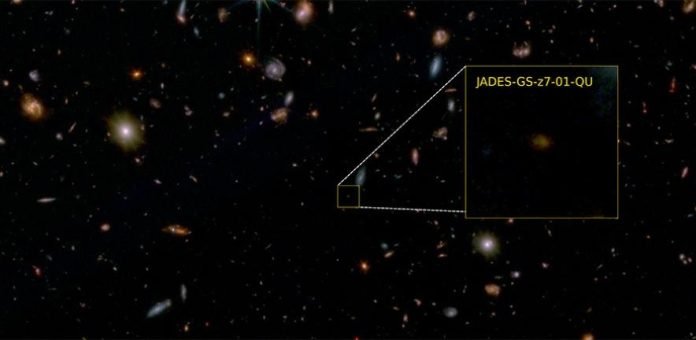
Astronomers have made a groundbreaking discovery using the James Webb Space Telescope: they’ve found the oldest galaxy that stopped making stars over 13 billion years ago.
This galaxy, observed by a team from the University of Cambridge, is like a cosmic ghost from a time when the universe was just a baby, about 700 million years old.
In the early days of the universe, galaxies were like star-making factories, constantly creating new stars from clouds of gas.
But this particular galaxy had a short-lived burst of star creation and then suddenly stopped, making it the earliest known “dead” galaxy.
This is surprising because, back then, the universe was full of gas – the main ingredient for making stars – kind of like an endless buffet for galaxies to feast on.
Why this galaxy stopped making stars so early is a big mystery.
Galaxies usually need gas to keep making stars, and something dramatic must have happened to cut off this galaxy’s supply.
It might have been something inside the galaxy, like a supermassive black hole, or maybe it used up its gas too quickly without getting any new supplies.
This discovery is shaking up our understanding of how galaxies grow and change over time. Before now, scientists used what they knew about more recent galaxies to guess how things worked in the early universe.
But finding a galaxy that stopped making stars so early on suggests that those old assumptions might not hold up.
The James Webb Space Telescope helped the astronomers see this galaxy in great detail.
They figured out that this galaxy had a frenzy of star-making that lasted between 30 and 90 million years, but then, about 10 to 20 million years before they observed it, the star formation came to an abrupt stop.
What’s really interesting is that this galaxy isn’t a massive giant; it’s actually quite small, about the size of the Small Magellanic Cloud, a dwarf galaxy near our own Milky Way. Previous discoveries of “dead” galaxies from the early universe were all much larger, but the James Webb Space Telescope’s powerful vision is now revealing smaller, fainter galaxies.
Although this galaxy seemed “dead” when observed, there’s a chance it could have started making stars again in the 13 billion years since. The astronomers are now on the lookout for more galaxies like this one to better understand why and how galaxies suddenly stop making stars.
This could reveal that galaxies in the early universe might have had periods of death followed by rebirth, a cosmic cycle of star formation and quenching.



